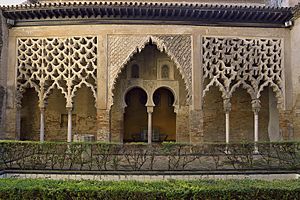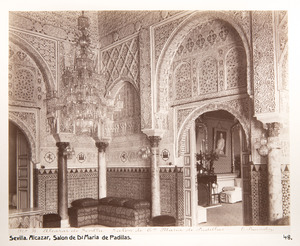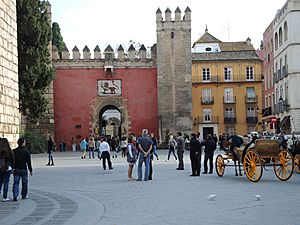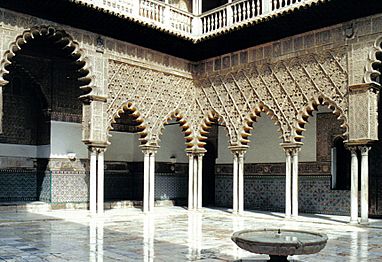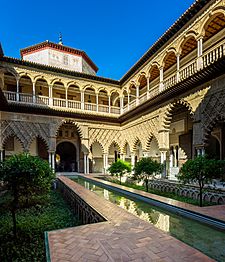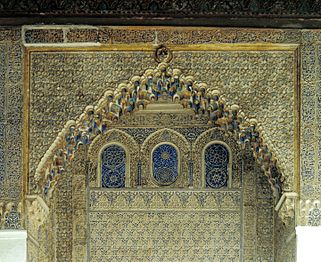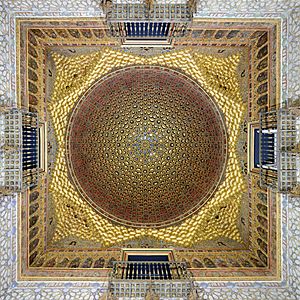Alcázar of Seville facts for kids
Quick facts for kids Royal Alcázars of Seville |
|
|---|---|
| Native name Spanish: Reales Alcázares de Sevilla |
|
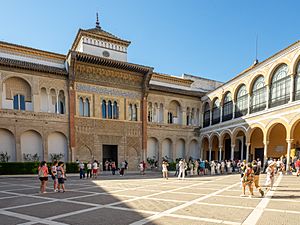
Patio de la Montería courtyard
|
|
| Type | Alcázar |
| Location | Seville, Spain |
| Type | Cultural |
| Criteria | i, ii, iii, vi |
| Designated | 1987 (11th session) |
| Part of | Cathedral, Alcázar and General Archive of the Indies in Seville |
| Reference no. | 383-002 |
| Region | Europe and North America |
| Type | Non-movable |
| Criteria | Monument |
| Designated | 3 June 1931 |
| Reference no. | RI-51-0001067 |
| Lua error in Module:Location_map at line 420: attempt to index field 'wikibase' (a nil value). | |
The Royal Alcázars of Seville (Spanish: Reales Alcázares de Sevilla) is a beautiful royal palace in Seville, Spain. It was built for the Christian king Peter of Castile on the site of an older Muslim fortress.
This palace is a great example of the Mudéjar style. This style mixes Romanesque, Gothic, and Renaissance building ideas with Islamic art. Parts of the Alcázar are still used by the Spanish royal family today when they visit Seville. In 1987, UNESCO named it a World Heritage Site, along with the nearby Seville Cathedral and the General Archive of the Indies.
Contents
What does "Alcázar" mean?
The word Alcázar comes from the Arabic word al-qaṣr. This means "the castle" or "the palace." The Arabic word itself came from the Latin word castrum, which also means "castle."
A Look Back in Time: The Alcázar's History
Early Islamic Times
In the year 712, Seville was taken over by the Umayyad Caliphate. Later, around 913–914, the first caliph of Al-Andalus, Abd al-Rahman III, built a strong fortress here. It was a square area, about 100 meters on each side, with walls and towers.
In the 11th century, a king named Al-Mu'tamid ibn Abbad made the complex bigger. He added a new palace called Al Mubarak.
Around 1150, the Almohad Caliphs made Seville their capital. They greatly expanded the fortress, almost doubling its size. They built many new palaces and courtyards. In 1163, Caliph Abu Yaqub Yusuf made the Alcázar his main home. He added even more parts to the palace in 1169. Most of the older buildings were taken down, and about twelve new palaces were built. One of these was a very large garden courtyard, now called the Patio del Crucero.
Not much of these early Islamic buildings remains today. You can still see parts of the Al Mubarak Palace under the Patio de la Monteria. Some old wall paintings are shown in the Palacio del Yeso.
The Christian Era
When Christians took over Seville, the Alcázar became the home of the Christian kings and queens. They changed the buildings to fit their needs.
From 1364 to 1366, King Peter of Castile built the beautiful Mudéjar Palace. This palace is a famous example of the Mudéjar style in Spain. Later, Queen Isabella and King Fernando made the upper floor bigger. They turned it into the main royal residence.
The palace was also the birthplace of Infanta Maria Antonietta of Spain in 1729. She was the daughter of King Philip V of Spain.
Exploring the Palace

The Royal Alcázar is located close to the Seville Cathedral. Over 500 years, many different building styles were added. You can see Islamic designs, Gothic and Romanesque elements, and Renaissance styles. After an earthquake in 1755, some parts were rebuilt in the Baroque style. This mix of styles makes the palace truly unique.
Beautiful Tiles
The palace is famous for its amazing tile decorations. Two main types of tiles were used: majolica and arista tiles. Arista tiles have raised lines that separate colors. Majolica tiles, developed later, allowed artists to "paint" directly onto the tiles with colorful glazes.
In the 16th century, an Italian artist named Francisco Niculoso made two majolica tile altarpieces for the royal chapel. One of these can still be seen today. Another artist, Cristóbal de Augusta, created a tile-work in the Gothic Palace with animals and flowers, making the walls look like bright tapestries.
Puerta del León (Lion Gate)
This is the main entrance to the Alcázar. It gets its name from a tile picture above the gate. This picture, added in the 19th century, shows a crowned lion holding a cross.
Patio de las Doncellas (Courtyard of the Maidens)
The name of this courtyard comes from an old story. It says that the Moors asked for 100 maidens each year as a tribute from Christian kingdoms.
The lower part of the Patio was built for King Peter of Castile. It has writings that call Peter a "sultan." The courtyard has a long, narrow pool surrounded by walkways.
The way this courtyard looks now is thanks to a restoration done in the 21st century. Archaeologists found the original garden and pool, which had been covered up with marble paving in the 1500s. The old Mudéjar garden was brought back to life.
The upper floor of the Patio was added by Charles V. It was designed in the Italian Renaissance style, but it also includes Mudéjar decorations. This part was built between 1540 and 1572.
Los Baños de Doña María de Padilla (Baths of Lady María de Padilla)
These are large rainwater tanks located under the Patio del Crucero. They are named after María de Padilla, who was the mistress of King Peter I.
Salón de Embajadores (Hall of Ambassadors)
This hall was originally the throne room, built in the 11th century. In the 14th century, King Pedro I redesigned it to be the most important room in his palace. He added beautiful plasterwork and tiled walls. In 1526, Emperor Charles V and Isabella of Portugal celebrated their wedding here.
Other Important Areas
The Alcázar has many other interesting rooms and courtyards:
- Palacio Mudéjar or de Pedro I: This is King Peter I's palace, known for its Mudéjar style.
- Patio de las Muñecas (Courtyard of the Dolls)
- Cuarto del Príncipe (Prince's Room)
- Salón del Techo de Carlos V (Charles V Ceiling Room)
- Salón del Techo de Felipe II (Philip II Ceiling Room)
- Palacio Gótico (Gothic Palace): Built between 1254 and 1578.
- Sala de las Bóvedas (Vaults' Room)
- Salón de los Tapices (Tapestries' Room)
- Upper Floors: These floors are still used by the royal family. Visitors can sometimes tour them for a small fee.
- Oratorio de Isabel la Católica (Oratory of Isabella the Catholic Monarch)
- Alcoba Real (Royal Bedroom)
- Cámara de Audiencias (Hearings' Chamber)
- Courtyards and Rooms:
- Patio de la Montería (Hunting Courtyard)
- Dormitorio de los Reyes Moros (Bedroom of the Moorish Kings)
- Sala de Justicia (Justice Room)
- Patio del Yeso (Plaster Courtyard)
- Cuarto del Almirante (Admiral's Room)
- Casa de Contratación (House of Trade)
- Patio del Crucero (Crossing Courtyard)
- Patio de Banderas (Flags Courtyard)
The Gardens
All old palaces in Al-Andalus had gardens with fruit trees, vegetables, and many fragrant flowers. These gardens provided food and were also beautiful places to relax. Water was always a key part of the design, with channels, fountains, and pools.
The gardens of the Alcázar of Seville have changed a lot over time. In the 17th century, an Italian designer named Vermondo Resta added the Italian Mannerist style. He created the Galeria de Grutesco (Grotto Gallery), which was an old Muslim wall turned into a covered walkway to enjoy the garden views.
Some of the famous gardens include:
- Estanque de Mercurio (Mercury Pond)
- Jardín de la Danza (Dance's Garden)
- Jardín de Troya (Troy's Garden)
- Jardín del Príncipe (Prince's Garden)
- Jardín de las Damas (Ladies' Garden)
- Jardín Inglés (English Garden)
- Jardín de los Poetas (The Poets' Garden)
See also
 In Spanish: Real Alcázar de Sevilla para niños
In Spanish: Real Alcázar de Sevilla para niños
- The Virgin of the Navigators
- Azulejo
- History of medieval Arabic and Western European domes


